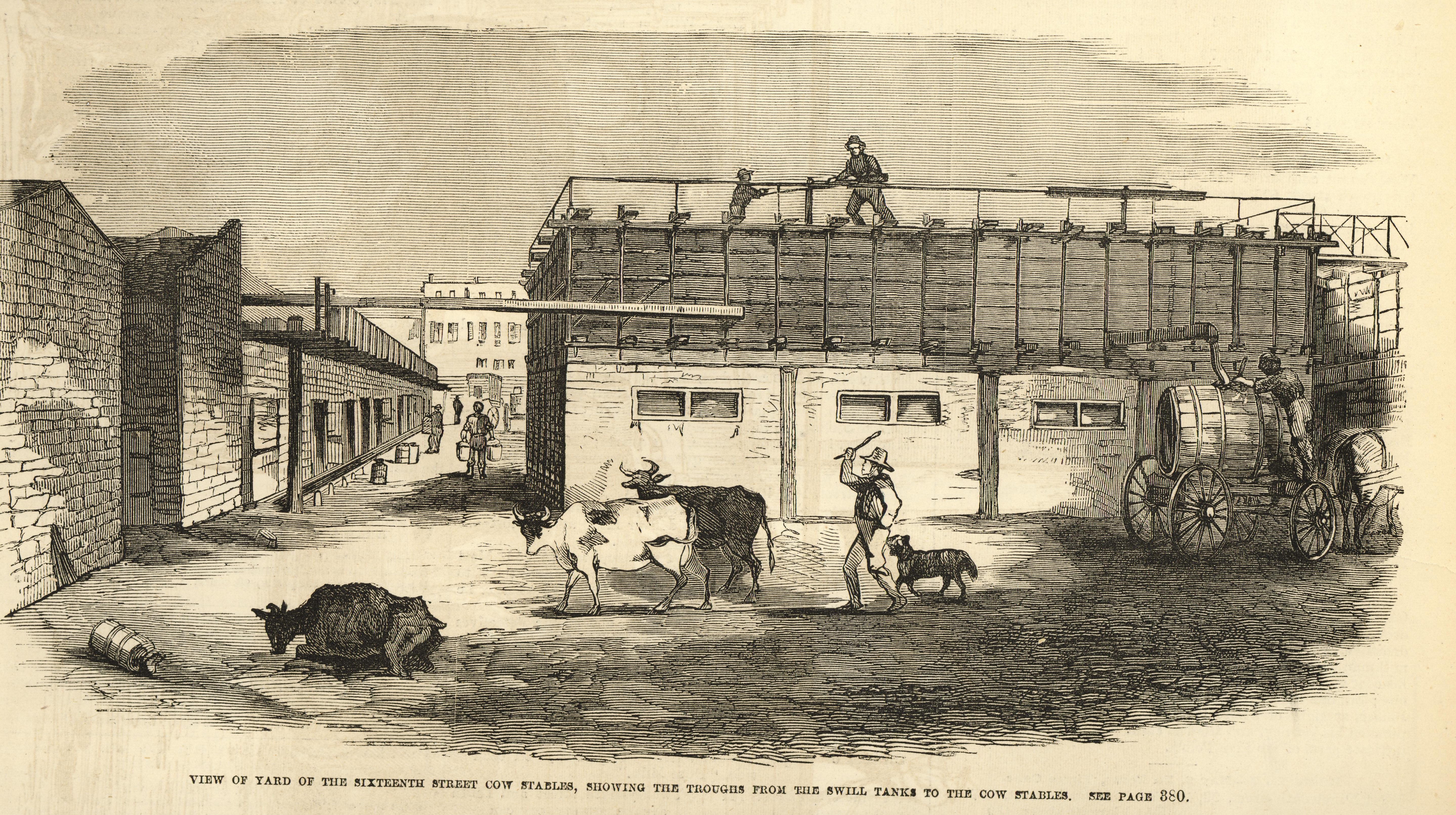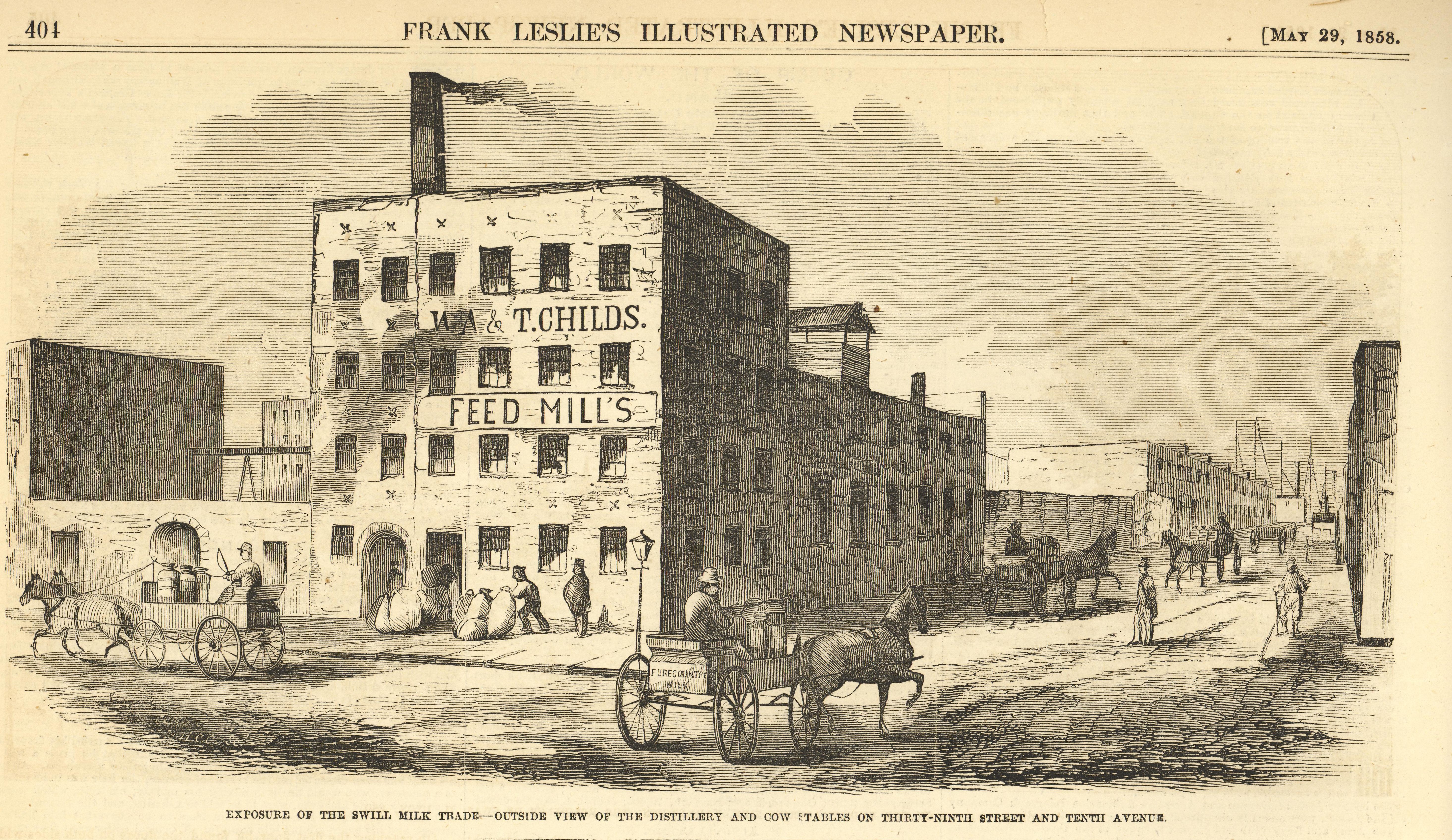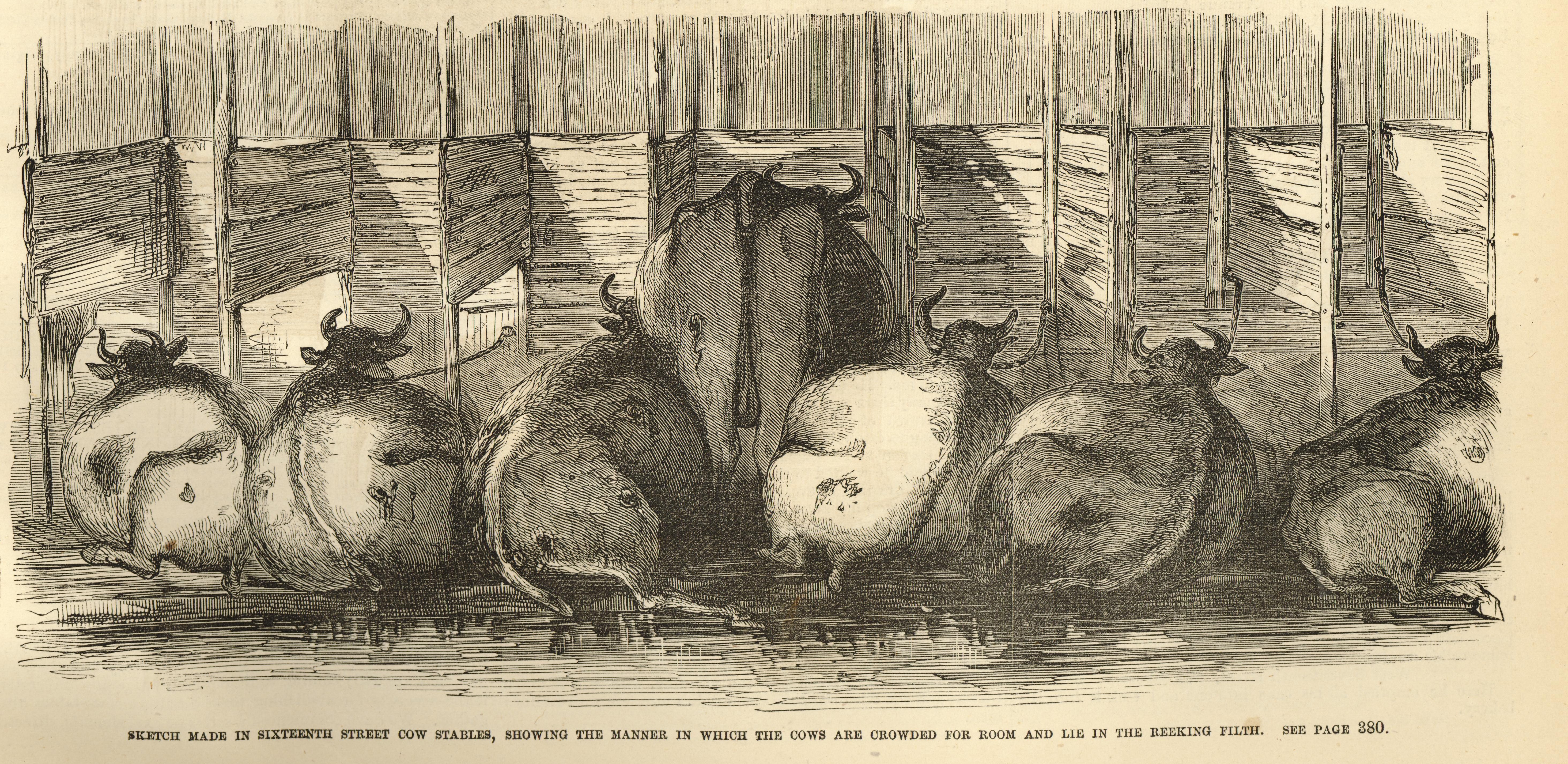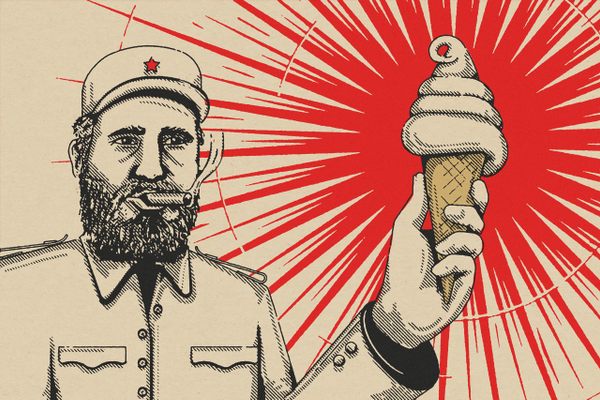The 19th-Century Swill Milk Scandal That Poisoned Infants With Whiskey Runoff
Vendors hawked the swill as “Pure Country Milk.”

In the 1850s, New York City babies were being mysteriously poisoned.
Nearly 8,000 babies a year shriveled to death from uncontrollable diarrhea, as reported by The New York Times. Without the luxury of advanced medical diagnostics, doctors struggled to identify the culprit. The public floated theories—nutritional and digestive diseases like cholera infantum and marasmus, to give name to the epidemic—but with little evidence, they ultimately gave a collective shrug. That is, until 1858, when an enterprising journalist named Frank Leslie unveiled the offender in a series of scathing exposés: milk.
Swill milk, to be exact—the tainted result of miasmic dairy cows being fed leftover mash from Manhattan and Brooklyn whiskey distilleries. It was the result of distillers looking to profit from their leftover grain. It was an especially lucrative era to be producing cow milk: Americans at the time considered cow milk to be highly nutritious and an effective substitute for breastmilk. Back then, economic and societal pressures pushed women to wean their babies sooner. In her book Taming Manhattan: Environmental Battles in the Antebellum City, Dr. Catherine McNeur writes that vendors sometimes sold swill milk for as little as six cents per quart, which especially appealed to lower-class mothers who needed to wean early so they could return to work. But the poor weren’t the only ones looking for a solution.
“[Middle-class women] were having numerous children, but also had to fulfill the obligations of politeness of middle class society, which required them to be available for visiting, and leading the household. In order to do those things, it was necessary they not be breastfeeding all the time,” says Dr. Melanie Dupuis, author of Dangerous Digestion: The Politics of American Dietary Advice. “Other theories for why women were weaning earlier include corsets, and women’s health during that time period, which tended to be poor. Also, men didn’t like their women to be breast feeding all the time. Some argue it was modesty.”
So New Yorkers gravitated towards “Pure Country Milk”—an intentional misbranding advertised across the side of swill milk wagons and on swill milk street-corner vendors’ signs. The fact that the chain between food consumer and producer had expanded during the city’s rapid expansion in the early 1800s exacerbated the problem. Bringing milk into Manhattan from rural farms in Orange and Westchester counties opened up the potential for it to spoil within the confines of a stifling railcar. Having “pure milk” dairies in urban areas, as opposed to rural farms, wasn’t a feasible option. New York City didn’t exactly have an abundance of grazing pastures, and shipping in natural food proved to be exorbitantly expensive. Thus deviously inventive distillers found a workaround: By attaching metal sheds to their facilities and piping in hot cereal byproduct as feed for cows, they could both produce milk in the city and make money off their waste.

Swill-fed cows were said to produce between five and 25 times more milk than their grass-fed counterparts, perhaps because, as The Times theorized, “the impurities of the animal’s body passed off with the milk.” It was a diet solely consisting of swill that proved particularly damaging to the cows. “When introduced to the boiling liquid, cows typically refused to eat for a few days, until desperation drove them to consume the slop,” McNeur writes. “A diet consisting exclusively of the swill made the cows sick, led to ulcerated sores all over their bodies, and caused their tails to fall off.” Because the resulting liquid was thin and had an unnatural, bluish tint, vendors stirred in additives such as chalk, flour, eggs, and Plaster-of-Paris to achieve a (slightly) more agreeable color and consistency.
By the late 1830s, swill made up “between 50 and 80 percent of all milk consumed in America’s large northeastern cities,” writes historian Richard A. Menkel in Save the Babes: American Public Health Reform and the Prevention of Infant Mortality. Temperance reformer Robert Hartley attempted to draw attention to the scourge in the 1840s; he even published a report linking swill milk and infant mortality. But his findings provoked little action because, as Menkel writes, “[Hartley’s] temperance intent limited public appeal.” New Yorkers of the era cherished their alcohol, and thus distrusted Hartley because they believed him to have an anti-distillery agenda.
While liquor-loving New Yorkers found themselves skeptical of Hartley’s motives, other factors inhibited his warnings from gaining traction. Wealthy distillers had political pull with officials, and largely enjoyed an absence of government regulation. And because swill milk purveyors hid sickly cows in windowless shacks, they easily bamboozled the public through false labeling. It also helped that germ theory had yet to gain widespread acceptance. “They can’t separate it out,” Dupuis says. “Children are dying of other things like diphtheria and tuberculosis. So you don’t have a public health system that can tell you why your kids are dying.”

Yet when Frank Leslie’s Illustrated Newspaper took on swill milk in 1858, it managed to incite mass uproar thanks to its powerful images and sensationalism. A Times article documented the origins of Leslie’s swill milk crusade: “Unpromisingly matters stood, when Frank Leslie found left at his door as milk a disgusting dose of milk and pus, which fairly threw his illustrated newspaper into an emetic convulsion. Bound to know the worst of the horrible story, he analyzed the specimen, and then dispatched his corps of reporters and artists to the head-quarters of the poison … He has reproduced pictures that are true to the life, and so shocking that the very word milk, or the sight of dainties into which it enters as an important component, turns the stomach. The whole town suffers nausea.”
Leslie, who had previously contributed illustrations to future circus mogul P.T. Barnum’s Illustrated News before founding his own paper in 1855, took out full-page ads in competing newspapers. There, he advertised his swill milk exposé series with dramatic lines such as: “Are you aware what kind of milk you are drinking?” He published precise maps depicting the street corners where swill milk was sold, and the dairies in which it was produced. He tasked his illustrators with infiltrating these locations. In addition to detailing their putrid conditions, they portrayed Irish dairy workers in offensive ways that stirred up anti-immigrant animus. It also led to some of the artists being attacked by the furious “milkmaids.”

With angry mobs congregating outside the dairies’ doors, the Common Council was pressured to send a team of New York City aldermen out to the premises for inspection—but suspiciously, they provided the distillery owners advance notice, allowing them time to sufficiently clean up the slipshod stables. “After hearings and inconclusive chemical analyses, the majority of the committee voted in favor of keeping swill milk, recommending only that the sheds have better ventilation,” McNeur writes. Three days later, a livid Leslie published an illustration that showed the politicians painting the feeble cows white, with one of the distillers slipping a bag of money into Alderman Michael Tuomey’s pocket. (Tuomey, a Tammany Hall puppet, would earn himself the nickname “Swill Milk Tuomey” for his efforts to obstruct health regulations.)
Despite little help from local government, Leslie’s continued activism led the New York state legislature to finally issue milk regulations in 1862. Nevertheless, issues with milk adulterants persisted until rail transport and pasteurization made it viable to get cold, pure milk into the city from rural farms. The matter was then helped further when, in 1906, Congress passed the Pure Food and Drug Act, which prevented “the manufacture, sale, or transportation of adulterated or misbranded or poisonous or deleterious foods, drugs, medicines, and liquor.”

Today, the Swill Milk Scandal’s tug of war between cheap, manufactured foods and natural, healthy variations has become more relevant than ever. Shades of it can be seen in controversies surrounding the labeling of organic and genetically modified foods, as well as in the practices of many factory farms and fast-food chains. (As recently as 2008, The Guardian reported a scandal in China where milk and infant formula had been cut with melamine, which sickened nearly 300,000 babies.) “The pressure was always, ‘How can we make milk both safe and affordable?’” Dupuis says. “Swill milk dairies show us that lack of transparency in how food is made has long been a problem.”
Gastro Obscura covers the world’s most wondrous food and drink.
Sign up for our email, delivered twice a week.

























Follow us on Twitter to get the latest on the world's hidden wonders.
Like us on Facebook to get the latest on the world's hidden wonders.
Follow us on Twitter Like us on Facebook